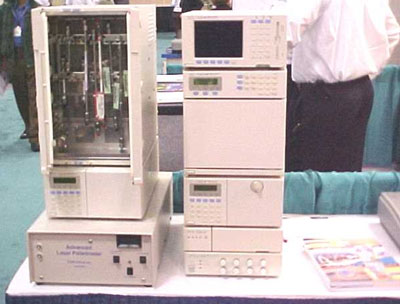From the Eastern Analytical Symposium: Better chiral separations
Contents
Two-week separations now done overnight
An emphasis on simplicity
Using antibiotics in separations
Separating enantiomers is often required in the drug development process. And with more and more molecular entities containing chiral centers being investigated as drug candidates today, new and better techniques are in demand to separate these mirror-image isomers. At the recent Eastern Analytical Symposium, instrument vendors and academicians alike offered ways to enhance chiral separations, both in speed and efficiency.
Two-week separations now done overnight
One exhibitor, PDR-Chiral Inc. (Palm Beach Gardens, FL), displayed a new system, called an automated Method Development Station, that allows users to run samples through up to 10 chiral HPLC columns and solvents to give a variety of chiral separations. According to Tom E. Carnes, the company's sales manager, the automated unit accomplishes the same number of separations overnight that would take two weeks with a non-automated chiral HPLC process.

Testing the separation properties of many different of column and solvent combinations is essential, Carnes tells Laboratory Network.com, because drug researchers need to develop methods in which the major enantiomer in a chiral mixture emerges from the column first, and other methods where the minor enantiomer emerges first. Methods also need to be developed, he adds, to distinguish which of these eluted isomers is which—a task accomplished by a laser polarimeter that is part of the PDR-Chiral automated system. (The columns and temperature control chamber in the system were developed in conjunction with Shimadzu Scientific Instruments, Carnes notes.)
An emphasis on simplicity
Experimentalists seeking to separate chiral mixtures with cyclodextrin columns must typically employ a whole range of buffer solutions for different classes of molecules, which often dissolve at widely different pH values. But Beckman Coulter Inc. (Fullerton, CA) has "rationalized" cyclodextrin separations, notes Joel Aliphon, the company's product marketing manager for North America. A current Beckman Coulter system, he explains is based on capillary electrophoresis using columns containing highly sulfonated cyclodextrin, which has a negative charge. With this medium, he notes, users need to have only three buffer solutions on hand. And the system is versatile enough, he adds, to separate chiral molecules that are acidic, basic or neutral; it can also separate zwitterions.
What about the separation efficiency of the Beckman Coulter CE system? Aliphon cites one example where two members of a chiral mixture are weakly resolved in an HPLC column, but have dramatically improved resolution with the CE/sulfonated cyclodextrin system. Specifically, he adds, the two enantiomers in this example have retention-time differences almost 20 times greater with the Beckman Coulter system than with standard HPLC columns.
Still, HPLC remain a staple of chiral separation systems in the laboratory. For this market, Akzo Nobel's Eka Chemicals division (Bohus, Sweden), has taken its highly spherical silica stationary phase materials, tradenamed Kromasil, and covalently bonded two types of chiral polymers—both derivatives of tartaric acid—to their surfaces. According to Lars G. Torstensson, director of sales and marketing in North America for Eka Chemical's separation products, the two types of Kromasil stationary phases complement each other, with each being suitable for separating different classes of molecules. Both Kromasil products can be used for analytical and preparative work.
Another active player in the chiral separations field, Chiral Technologies Inc. (Exton, PA), did not show any new products at the Atlantic City meeting. But a technical-session speaker from the company, Ronald J. Bopp, described many applications of chiral derivatized polysaccharide stationary HPLC phases his firm has previously developed. In one example, he noted that these media can be used with an unusual solvent mixture consisting of carbon dioxide (in the supercritical or subcritical state) blended with an alcohol or acetonitrile. Such a solvent combination has several advantages, Bopp pointed out. For one thing, he said, CO2 has a very low viscosity, which expedites HPLC separations. Another plus, he added, was the slight acidity of CO2, which eliminates the need to incorporate additives (such as trifluoroacetic acid) to solutions when separating analytes containing carboxylic acid functional groups.
Using antibiotics in separations
The "newest and fastest growing" stationary phases in chiral separations are the macrocyclic glycopeptide antibiotics, said chemist Daniel W. Armstrong of Iowa State University (Ames, IA) at the technical session devoted to chiral separations. He described recent investigations he's done on the molecular recognition mechanisms of these classes of molecules, which include Vanomycin, Teicoplanin and Ristocetin A. Using this understanding of reactivity, he explained why certain of these antibiotics combined with certain solvent systems are better at resolving some amino acid mixtures than are other combinations.
Meanwhile, one exhibitor, Advanced Separation Technologies Inc. (Astec; Whippany, NJ), introduced a new chiral method development kit geared to the macrocyclic glycopeptide antibiotics. According to J.T. Lee, the company's methods development manager, the kit contains three 10 cm HPLC columns, each filled with one of the macrocyclic peptides. It also includes column couplers, a handbook describing the antibiotic materials, and an operating manual. Users can mix and match different column and solvent combinations in a particular order to develop the optimal screening methods for their chiral mixtures. According to Lee, the new Astec kit is targeted at high throughput screening of compounds in pharmaceutical research.
By Gordon Graff
Managing Editor, Laboratory Network.com
Email: ggraff@vertical.net
